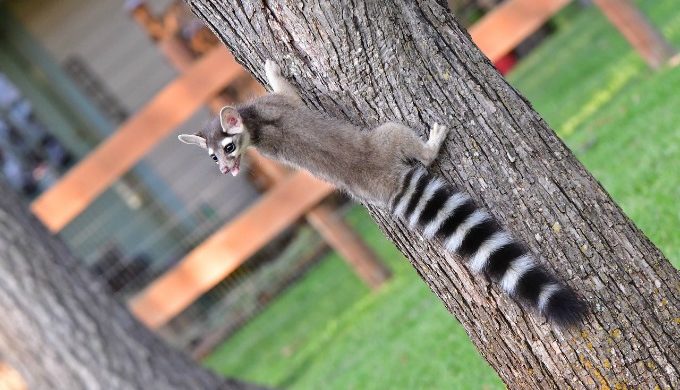What is this cute little creature that sometimes appears, under the cover of darkness, on neighbors’ game cameras? If you live near the Texas Hill Country, then it might be a ringtail. Notoriously nocturnal and devastatingly adorable, these native animals typically live a solitary existence but may share a den with family members. While they’re often mistaken for cats, ringtails are actually a member of the raccoon family.
Nature
Is That a Cat or a Fox? Nope, It’s a Texas Hill Country Ringtail
Armed With a Foot-Long Tail

Photo: Miguel Lecuona/Hill Country Light Photography
Since the ringtail is a nocturnal creature, its large eyes and upright ears make it easier to move about in the dark. Its fur ranges in coloring from tawny to grayish, with a pointed muzzle with long whiskers that resemble that of a fox.
The ringtail’s tail is about a foot in length, with seven to nine black rings and is about the same length as the animal’s body. Like its namesake, the ringtail uses this tail for balancing when moving about its habitat. The tail also serves another purpose: acting as a distraction for potential predators. The white rings provide predators with a focus other than the animal itself. By grabbing the tail rather than the body, the ringtail has a greater chance of escaping.
An Impressive Animal Athlete

Photo: Miguel Lecuona/Hill Country Light Photography
The ringtail is a very agile animal and their semi-retractable claws and long tail provide the animal with tools ideal for climbing. This agility is attributed to their balancing beam-like tails and unique ankle joints, which are flexible and can rotate 180 degrees. The ringtail produces a variety of sounds, including clicks and chatters reminiscent of raccoons, so if you listen closely at night, you just might hear one.
Ringtail Diet and Habitat

Photo: Miguel Lecuona/Hill Country Light Photography
These animals are almost wholly nocturnal and spend the majority of the day sleeping in their dens. They leave their dens at night to feed. Ringtails eat a wide variety of foods. Birds, rodents, carrion, reptiles and amphibians, and insects such as grasshoppers and crickets form the bulk of their diet, although they also eat native fruits and berries as well.
Ringtails live in many different habitats, but they prefer rocky areas such as rock piles, stone fences, canyon walls, and talus slopes. Ringtails are expert climbers, capable of climbing vertical walls to find the most protected crevices, crannies, and hollows in which to build their dens. In woodland areas, where they are less common, they den in hollow trees and logs. They have also been observed living in buildings. They’re notoriously shy and are rarely seen in daylight in Texas. To learn more about ringtails, visit the Texas Parks and Wildlife website.


